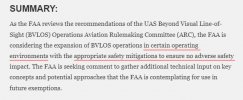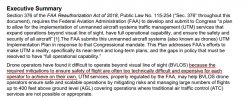Just for clarification, the FAA AC's (Advisory Circulars), are publications meant to provide further guidance for compliance to regulations. AC 107-2A is for Title 14 Part 107 operations. And for the recreational 44809 regulations there is AC 91-57C.I would like that to be stated in the law, for clarification. You and I know this but a lot of people may not. And maybe it's in the law but sometimes people don't pick up on that.
Below is from AC 107-2A
5.9 VLOS Aircraft Operation.
The remote PIC and person manipulating the controls must be able to see the small unmanned aircraft at all times during flight (§ 107.31). The small unmanned aircraft must be operated closely enough to ensure visibility requirements are met during small UAS operations. This requirement also applies to the VO, if used, during the aircraft operation.
The person maintaining VLOS may have brief moments in which he or she is not looking directly at or cannot see the small unmanned aircraft, but still retains the capability to see the small unmanned aircraft or quickly maneuver it back to VLOS. These moments may be necessary for the remote PIC to look at the controller to determine remaining battery life or for operational awareness.
Should the remote PIC or person manipulating the controls lose VLOS of the small unmanned aircraft, he or she must regain VLOS as soon as practicable. Even though the remote PIC may briefly lose sight of the small unmanned aircraft, the remote PIC always has the see-and-avoid responsibilities set out in §§ 107.31 and 107.37. The circumstances that may prevent a remote PIC from fulfilling those responsibilities will vary, depending on factors such as the type of small UAS, the operational environment, and distance between the remote PIC and the small unmanned aircraft.
For this reason, no specific time interval exists in which interruption of VLOS is permissible, as it would have the effect of potentially allowing a hazardous interruption of the operation. If the remote PIC cannot regain VLOS, the remote PIC or person manipulating the controls should follow pre-determined procedures for the loss of VLOS. The capabilities of the small UAS will govern the remote PIC’s determination as to the appropriate course of action. For example, the remote PIC may need to land the small unmanned aircraft immediately, enter hover mode, or employ a return-to-home sequence. The VLOS requirement does not prohibit actions such as scanning the airspace or briefly looking down at the small unmanned aircraft CS.













